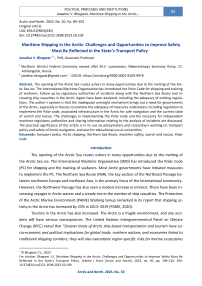Maritime Shipping in the Arctic: Challenges and Opportunities to Improve Safety Must Be Reflected in the State’s Transport Policy
Автор: Bhagwat J.V.
Журнал: Arctic and North @arctic-and-north
Рубрика: Political processes and institutions
Статья в выпуске: 50, 2023 года.
Бесплатный доступ
The opening of the Arctic Sea routes ushers in many opportunities due to the melting of the Arctic Sea ice. The International Maritime Organization has introduced the Polar Code for shipping and training of seafarers. Follow up by regulatory authorities of incidents along with the Northern Sea Route and increasing ship casualties in the Arctic region have been analyzed, including the adequacy of existing regulations. The author’s opinion is that the inadequate oversight mechanism brings out a need for governments of the Arctic, especially in Russia, to examine the adequacy of measures undertaken, including regulation to implement the Polar code, associated infrastructure in the Arctic for safe navigation and the current state of search and rescue. The challenges in implementing the Polar Code and the necessity for independent maritime regulatory authorities and sharing information relating to the analysis of incidents are discussed. The practical significance of the article is in its use by policymakers and researchers working on transport policy and safety of Arctic navigation, and also for educational use at universities.
Transport policy, Arctic shipping, Northern Sea Route, maritime safety, search and rescue, Polar Code
Короткий адрес: https://sciup.org/148329282
IDR: 148329282 | УДК: 656.61(985)(045) | DOI: 10.37482/issn2221-2698.2023.50.109
Текст научной статьи Maritime Shipping in the Arctic: Challenges and Opportunities to Improve Safety Must Be Reflected in the State’s Transport Policy
The opening of the Arctic Sea routes ushers in many opportunities due to the melting of the Arctic Sea ice. The International Maritime Organization (IMO) has introduced the Polar Code (PC) for shipping and the training of seafarers. Most Arctic governments have initiated measures to implement the PC. The Northern Sea Route (NSR), the key section of the Northeast Passage between northwest Europe and northeast Asia, is the primary focus of the international community. However, the Northwest Passage has also seen a modest increase in interest. There have been increasing voyages in Arctic waters and a steady rise in the number of ship casualties. The Protection of the Arctic Marine Environment (PAME) Working Group remarked in its report that shipping activity in the Arctic has increased by 25% in 2013–2019 (PAME, 2020).
Tourism in the Arctic has also increased. The Arctic is a fragile environment, and any accident will have serious consequences. The United Nations Intergovernmental Panel on Climate Change (IPCC) noted that “ Greater levels of Arctic ship-based transportation and tourism have socio-economic and political implications for global trade, northern nations, and economies linked to traditional shipping corridors; they will also exacerbate region-specific risks for marine ecosystems
∗ © Bhagwat J.V., 2023
and coastal communities if further action to develop and adequately implement regulations does not keep pace with increased shipping (high confidence) ” (IPCC, 2019). State transport policy has the responsibility for ensuring safety of the transportation process and the equipment (means of transport and infrastructure) involved in such a process [1, Gorbunov A.A., pp. 2-49]. This article will analyse the extent to which the PC may be adequate in meeting the challenges of shipping safety in the Arctic, given the limitations of search and rescue (SAR) assets. It suggests what lessons could be drawn from the experience of the last decade of heightened activity by Arctic states in the formulation of transport policy and regulation, especially by Russia.
Research on Arctic shipping has mainly deliberated on the NSR for trans-Arctic transit between the Pacific and the Atlantic. The NSR is a potential maritime trade route between ports in northwest Europe and northeast Asia due to shorter transport distance (30%–50% less) and reduced sailing time (14–20 days) compared to the Suez route, assuming the same speed. Over the past decade, several studies have evaluated shipping on the NSR and related infrastructure: for 2011–2013 [2, Moe A., pp. 784-802]; for 2013 [3, Humpert M., pp. 1-20], [4, Marchenko N., pp. 1-10]); transit-trend analysis for both the NSR and the Canadian Northwest Passage for 2007– 2012 [5, Lasserre F., Alexeeva O., pp. 180-192]; analysis of transit data on the NSR [6, Zhang, Y., Meng, Q., & Zhang, L., pp. 53-60]; analysis of NSR shipping from 2011-2020 [7, Gunnarsson B., Moe A., pp. 4-30] , the overall impact of Arctic shipping [8, Chircop A. et al., pp. 1-319], [9, Lasser-re F., Faury O. pp. 1-250], an overview of the legal search and rescue framework and infrastructure [10, pp. 1-9] These studies indicate that Arctic transit shipping has grown modestly, primarily along the NSR. Current shipping is mostly destination-oriented, which is related to natural resource extraction centres.
Many studies have analysed various issues concerning the implementation of the PC and Port State Control (PSC) by Arctic countries: Regulation of merchant shipping [11, pp. 225-257]; [12, pp. 272-298]; Article 234 of UNCLOS and the PC [13, pp. 1-71]; Analysis of the PC from a legal perspective [14, Vylegzhanin A.N., pp. 43-60]; regarding implementation of the PC [15, Grant A.N., pp. 190-205], [16, Zagorski A., pp. 292-305]; International code for operating in polar waters and legal implications [17, Jensen O., pp. 60-82]; critical assessment of the PC from a Russian perspective 1, regarding the role of the PC in Arctic Maritime Governance [18, Hindley, pp. 182-192]; enhanced port control in Arctic waters [19, Bai J., Wang C., pp. 1-21];cooperation in the area of port control in the Arctic [20, pp. 160-176]; deficiencies in the PC from a Russian perspective [21, pp. 322-333]; implementation of the PC on the NSR [22, pp. 30-42] and discussion on the implementation of the PC and the STCW’s convention’s training requirements for ice navigation in polar waters [23, pp. 160-176].
The research mentioned above also highlights the weak infrastructure and inadequate SAR assets. The theoretical studies on the PC indicate certain limitations of goal-based standards of the PC. Some researchers have also indicated the need for greater control of the operation of vessels with flags of convenience (FOC). This research attempts to analyse the issue by representing two case studies and suggesting a way ahead.
Section 2 of the article presents data sources and methodology. Section 3 examines Arctic shipping; Section 4 covers the follow-up analysis of two accidents and the adequacy of the oversight mechanism for incident analysis in Russia and Norway. Section 5 gives an overview of the current state of Search and Rescue, and Section 6 includes an analysis of the issue of FOC. Finally, Section 7 puts forward recommendations to improve the safety of Arctic shipping.
Research methodology
The article first presents data sources, methodology, analysis of two accidents and overview of mechanism to disseminate lessons learnt in Russia and Norway, state of search and rescue, and recommendations to improve the safety of Arctic shipping. The study greatly benefitted from the study by Gunnarson and Moe on ten years of international shipping on the NSR, assessment of Arctic shipping by the PAME Working Group, official transit statistics 2013–2019 and information on accidents available on the website of the Northern Sea Route Administration (NSRA). In addition, information on vessel characteristics and shipping companies/operators was found on marinetraffic.com. Internet sources were used to check the characteristics of various shipping activities, especially accidents, since not enough research has been done in this area.
The significance of the research can be found in the risks associated with shipping in the Arctic, the regulatory framework of the PC and the increasing accidents in the Arctic. This accentuates the need for greater cooperation between the Arctic and the non-Arctic states. The article aims to draw attention to the challenges and suggest measures to enhance the safety of Arctic shipping. The methodological basis of the research is analysis and synthesis, description and explanation, dialectical approach, systemic and comparative analysis. Systemic analysis of Arctic shipping is relevant because of linkages between the system or policy choices made by the IMO and Arctic governments and the Arctic environment. Comparative analysis was used to compare the approach to incidents by the Norwegian and Russian authorities. The dialectical approach is most relevant as it assists in analysing the problem of Arctic shipping from different perspectives and then getting a suggested solution.
Shipping in Arctic waters
The shipping in Arctic waters is slowly and steadily growing, primarily along the NSR. The commercial potential is likely to be most important for countries of North-East Asia, namely Japan, South Korea and China, since their goods could become potentially cheaper to other manufacturing hubs in South-East Asia and India if transported via the North-East passage parallel to Russia’s northern border, or the Northern Sea Route. Most cargo shipments along the NSR are related to supplies of natural resources from the Arctic or supplies of equipment and cargo to resource extraction facilities. There were only 51 international transits in 2016–2019. Most of the cargo are from Asia (28 voyages or 60%) and primarily from China (19 voyages) [7, Gunnarsson B., Moe A., pp. 4-30]. The North-West passage through the Canadian Arctic islands would potentially apply to trade between North-East America and North-East Asia (north of Shanghai). However, this route is less commercially attractive as the direct route is more prone to ice blockage, and the circuitous route, constrained by draught limitations, is mostly frequented by research vessels and cruise ships 2. There is also a possibility of a third route over the North Pole, and this has been given the designation of the Polar Silk Road since it is being researched primarily by China.
Ship accidents in Arctic waters – dissemination and regulatory mechanism Ship casualties in Arctic waters
The number of ship casualties in Arctic water is depicted in Table 1, and they vary from 40 to 70 in the period 2010-2020 3. Analysis of this table reveals that the total number of incidents showed a rising trend till 2017, a decline in 2018 and 2019, and again a rise in 2020 due to the inclusion of incidents related to COVID-19 in the miscellaneous category. However, thereafter it shows a falling trend. It may be noted that the accuracy of this table depends upon the accuracy of reporting by various countries. Hence, this decreasing trend, while giving a cause for optimism, may also be due to non-reporting of incidents as brought out above. Unless there is mandatory reporting and common standards across Arctic countries, such a table will only be a broad indicator of ship casualties. However, the table brings out the need for continued vigilance considering the harsh Arctic environment and the limited reach of search and rescue assets [8, Chircop A., pp. 229–232].
Table 1
Ship casualties — Arctic Circle waters, 2010–2020 (ships of 100 gross tons or more) 4
|
Type of Casualty |
2010 |
2011 |
2012 |
2013 |
2014 |
2015 |
2016 |
2017 |
2018 |
2019 |
2020 |
|
Machinery damage/ failure |
16 |
12 |
13 |
20 |
27 |
44 |
32 |
46 |
23 |
14 |
18 |
|
Wrecked/ Stranded |
9 |
9 |
8 |
10 |
14 |
6 |
11 |
9 |
8 |
6 |
8 |
|
Fire/explosion |
6 |
6 |
2 |
4 |
2 |
4 |
1 |
3 |
6 |
1 |
8 |
|
Collision involving vessels |
10 |
4 |
4 |
2 |
0 |
3 |
2 |
4 |
2 |
3 |
6 |
2 Rourke R. Changes in the Arctic: Background and Issues for Congress, US Congressional Record Service. March 24, 2022. URL: (accessed 31 July 2022).
|
Contact (e.g. harbour wall) |
4 |
1 |
3 |
6 |
4 |
5 |
1 |
1 |
0 |
0 |
1 |
|
Foundered (i.e. sunk or submerged) |
0 |
3 |
1 |
1 |
2 |
0 |
1 |
0 |
1 |
0 |
2 |
|
Hull Damage (holed, cracks, etc.) |
2 |
2 |
1 |
2 |
1 |
1 |
2 |
2 |
1 |
1 |
0 |
|
Labor dispute |
0 |
3 |
1 |
1 |
2 |
0 |
1 |
0 |
0 |
8 |
0 |
|
Miscellaneous |
4 |
2 |
6 |
5 |
5 |
6 |
4 |
6 |
0 |
8 |
15 |
|
Total |
50 |
39 |
38 |
50 |
55 |
69 |
55 |
71 |
44 |
41 |
58 |
Causes of casualties/incidents 2020
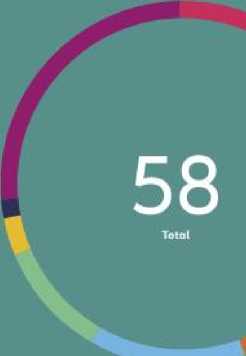
|
Machinery damoge/todure |
18 |
|
Гие/е* plosion |
8 |
|
1 Wrecked/stranded |
8 |
|
В Collator |
6 |
|
В Foundered |
2 |
|
Contact |
1 |
|
Miscellaneous |
IS |
Including 2 total losses
Vessels over 1COGT or#у
Analysis shows there were 58 reported shipping incidents in Arctic Circle waters during 2020 - up by 17 year-on-year. This represents the highest total for three years. There were two total losses involving fishing vessels. The number of miscellaneous events was driven by incidents involving crew members on vessels testing positive for Covid-19, requiring quarantine and delays to journeys.
Source Load's Let I ntalbgcnco Casualty Statistics
Fig. 1. Ship casualties — Arctic Circle waters, 2020 (ships of 100 gross tons or more) 5
Arctic tourism and associated hazards
The Arctic Shipping Status Report stated that 73 cruise ships sailed in the Arctic PC area in 2019 compared to 65 in 2018, following the overall increase in Arctic tourism. However, experts have noted the vulnerability of cruise ships carrying large numbers of passengers that may experience problems and need assistance 6.
Two incidents in 2018 and 2019 associated with the increased number of cruise ships in the Arctic are worthy of attention. On August 24, 2018, a Russian-flagged passenger ship with 162
people was cruising on Canada’s Northwest Passage 7. In March 2019, the Viking Sky cruise ship suffered engine failure with 1373 people on board when sailing from Tromsø to Stavanger in Norway. When it encountered bad weather, the ship sailed despite a weather warning. The vessel, which avoided grounding, was left without power or propulsion and had to rely on rescue helicopters to evacuate passengers as sea conditions did not allow for the use of lifeboats or tugs 8.
The 2019 engine failure incident involving the cruise ship demonstrates how such events could quickly turn into a major disaster, mainly in remote waters such as the Arctic, where a growing number of such vessels are expected to operate in the future. Two accidents will be analysed because they highlight the concerns reflected above.
Analysis of the action taken on Incident 1 – Viking Sky
The ship was two years old, and there were 915 passengers and 415 crew members onboard “ in search of the Northern lights ” 9. Viking Sky sailed from Tromso on March 21, 2019, and was supposed to arrive in Tilbury, Essex, despite the shipping forecast of rough seas and stormy weather. The emergency alert was announced at 14.00 on March 23 after the ship lost its running gear and began to drift to land, about 200 miles south of the region, where compliance with the norms of the PC published by the IMO is mandatory. 479 passengers were evacuated by helicopter to Molde in groups of 15-20 people by 10.30 on March 24, 2019 10. Three years after the incident, no information regarding the lesson learnt and near-miss analysis could be found on the websites of The Norwegian Maritime Administration or the Accident Information Board (AIBN) (Figure 2) linked to the former website (Norwegian Maritime Administration, 2021) 11. The AIBN is legally authorised to analyse all incidents, including near misses. According to the Norwegian Safety Investigation Authority website (Figure 3), the incident is still being investigated (Norwegian Safety Investigation Authority, 2021 12.
-
9 Calder S. Viking Sky: Why Things Went Wrong, What Happened and What’s Next. Independent, 24 March 2019. URL: https://www.independent.co.uk/travel/news-and-advice/viking-sky-what-happened-storm-norway-emergency- evacuation-coast-a8837371.html (accessed 31 July 2022).
-
10 Ibid.
-
11 The Norwegian Maritime Administration. The Accident Information Board.
(accessed 31 July 2022).
URL:
-
12 The Norwegian Safety Investigation Authority.
Current Investigations.
URL:
(accessed 31 July 2022).
< Investigation of accidents
The Norwegian Maritime Authority
The Police
The Accident Investigation Board
Norway (AIBN)
IMO - lessons learned
Safety alerts
Marine Accident investigators'
International Forum (MAIIF)
6 tf The Accident Investigation Board Norway (AIBN) - Norwegian Maritime Authority
Перевод- ^r Google Перевод- К* Flight Reservation fit Flights: Find Chea। ^ Google Перевод- Преподаватель E ® Яндекс.Перевод- в (47C You are here: Norwegian Maritime Authority - Start page Shipping Accidents and safety Investigation of accidents The Accident Investigation Board Norway (AIBN)
The Accident Investigation Board Norway (AIBN)
PUBLISHED: 10/04/2012
The AIBN is a public committee of inquiry whose purpose it to investigate accidents and incidents within the transportation sector.
The AIBN is an investigating authority in accordance with chapter 18 of the Norwegian Maritime Code. The objective of AIBN is to determine the course of events and causes of an accident, give an account of circumstances significant to the avoidance of accidents and improving the safety of life at sea, and to submit and publish a report with any recommendations upon the conclusion of the investigation.
It is not the task of AIBN to apportion civil or criminal blame and liability.
Link to AIBN, Shipping Department (Norwegian site)
Link to reports published by the AIBN, Shipping Department
Fig. 2. Screenshot of The Accident Investigation Board-Norway website 13 .
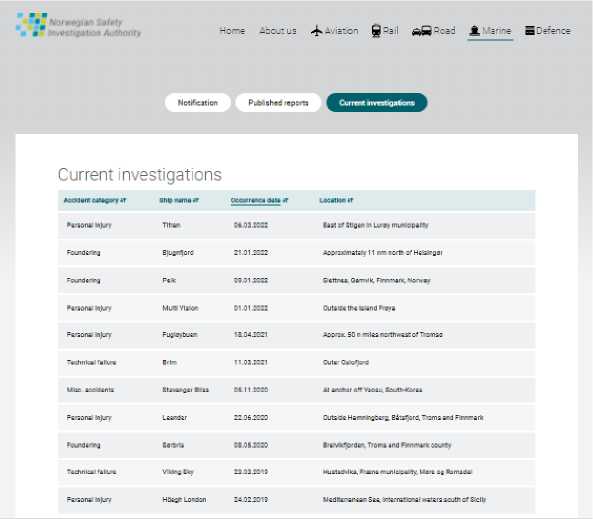
Fig. 3. Screenshot of the Norwegian Safety Investigation Authority 14 .
Analysis of the action taken on Incident 2 – Boris Vilkitsky incident
In April 2018, the liquefied natural gas (LNG) carrier Boris Vilkitsky (operated by the Cyprus company Dynagas, a flag of convenience vessel) entered the NSR waters violating the NSR navigation rules, when damage to one of its three engines reduced its ice capabilities from Arc 7 to Arc 4 (Northern Sea Route Authority, 2021). The LNG carrier Boris Vilkitsky entered Sabetta (Northern Sea Route Authority, 2021). Other violations noticed by the authorities included: the lack of suffi- cient ice experience of the captain and his crew and the lack of accurate ice charts. He was allowed to leave at the request of the Federal Government 15. The Northern Sea Route Administration website does not contain information about the actions taken against the company that concluded the contract with the vessel, as well as the owner or captain of the vessel 16. After the incident with Boris Vilkitsky in April 2018, there is still no information (see Figure 4) about action taken, and other subsequent incidents reported in the Russian media on the administration of the Northern Sea Route website 17. The Federal Service for Supervision of Transport (Rostransnadzor) publishes typical violations on its website. However, there are no incident analysis or action taken reports related specifically to the NSR 18, 19. In 2021, there was a widely reported case of 20 vessels being stuck in ice along the NSR 20. This issue has no mention on both websites. Reportedly, in response to this incident largely attributed to unexpected bad weather, Rosatom has been given more powers to control shipping along the NSR and the earlier organisation of Glavsevmorput (1932–1965) has been resurrected, albeit in a new form within the framework of Rosatom 21. It may be noted that a similar accident had taken place in 1983 [24, Bhagwat J., pp. 72-73]. However, there is apparently no campaign to increase safety culture and risk understanding as a followup action to these incidents.
Ibid.
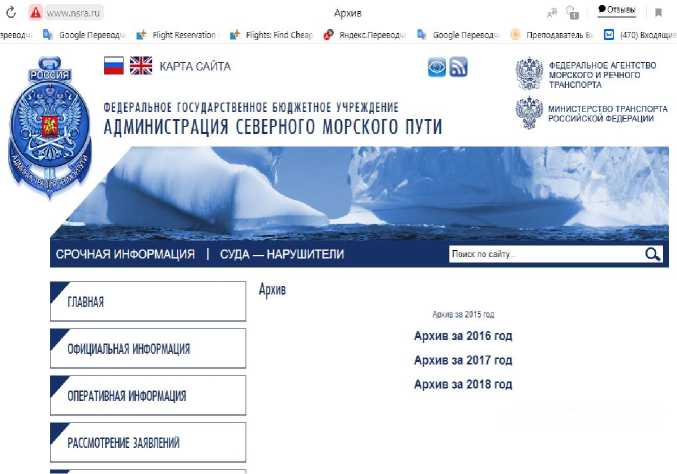
Fig. 4. Screenshot of the Northern Sea Route Administration website (in Russian) 22 .
Inference – role of Arctic maritime regulatory authorities
The analysis of the two accidents above indicates that maritime authorities in both Norway and Russia have not been diligent about analysing the accidents and near misses. Norway has an established publically declared procedure, but in this case, implementation has been clearly tardy. This disturbing trend is noticed in both countries and it needs to be curbed. This could also lead to the non-reporting of near misses and incidents by ship owners. Research of various regulatory mechanisms for reporting and analysis of such occurrences prevalent in various countries reveals that the British law may be useful as a guideline for all Arctic states and non-Arctic states interested in using the Arctic.
According to the United Kingdom (UK) Merchant Shipping (Accident Reporting and Investigation) Regulations 2012, “ The sole objective of the investigation of an accident under shall be the prevention of future accidents through the ascertainment of its causes and circumstances. It shall not be the purpose of an investigation to determine liability nor, except so far as is necessary to achieve its objective, to apportion blame ” 23. All reports are available on the website for dissemination to all concerned, and this includes incidents involving civilian and naval vessels. We are of the opinion that this regulation and the website with its compilation of reports could be a model to be followed by all Arctic Council countries in letter and in spirit.
Search and Rescue – The Achilles heel of Arctic shipping
The above-mentioned incidents accentuate the criticality of search and rescue (SAR) assets and the need for mutual cooperation. There is an agreement that was signed in 2011 to delineate areas of responsibility (Fig. 5) for search and rescue 24. However, Article 12 of the agreement not- ed that implementation is subject to availability of resources.
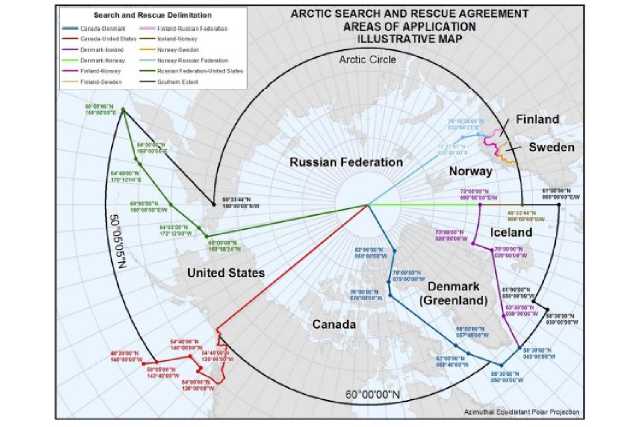
Fig. 5. Arctic SAR areas in Arctic SAR agreement 25 .
Six years later, in 2017, a survey was carried out by the Finish Border Guard amongst the
Arctic Coast Guard Forum, and it highlighted key challenges for Arctic search and rescue. These included long distances, severe weather, ice and cold conditions, a poor communications network, a lack of infrastructure, and deficiency of SAR assets in the North. Use of unmanned aerial vehicles for various purposes, including ice monitoring, navigation, geophysical and meteorological surveys is still at a nascent stage in the Russian Arctic. In the last decades, emergency preparedness resources in the Arctic have been significantly strengthened through the addition of available vessels and helicopters by Arctic states 26. However, the response time may still be long and the capacity may be limited if major incidents occur [25, Marchenko et al., pp. 107-114]. Moreover, there is unreliable communication above 70 degrees North latitude. Table-top exercises are being carried out periodically, but these are no substitute for regular live exercises where actual capabilities in real weather and sea conditions will be tested. A positive step in this regard was the first ever international search and rescue exercise in the Arctic Circle that took place in December 2021. It tested the ability of a group of people to survive a 24 hour period in the severe cold 27. However, no mobilisation of SAR assets took place.
Flags of Convenience
Meanwhile, there is a particular risk that the shortcomings of the Polar Code in the Arctic region could be worsened by flags of convenience (FOCs). According to the most widely accepted criteria for defining FOCs, one of the main features of such states is that they do not have the power to effectively impose domestic or international regulations. Similarly, they are not interested in exercising control over shipping companies [26, pp. 1-31]. Therefore, ships registered under FOCs have a relatively worse safety record than non-FOC vessels [26, pp. 1-31]. According to estimates, the average share of voyages related to FOC through the NSR for 2017-2019 amounted to 7–8% (47 out of total 664 voyages in the NSR in 2017, 46 out of 792 in 2018, 55 out of 799 in 2019) [21, Todorov A., pp. 322-333]. Similar percentages are indicated for 2020 and 2021 (77 out of 1014 in 2020, 80 out of 1235 in 2021) with a lesser percentage until 01 December 2022 (53 out of total 1104 voyages), possibly due to the current geopolitical crisis (see Figure 6) 28. This research indicates that vessels under FOCs are present in the Arctic, and the average share of all foreign vessels, except 2022, is about 50%. Boris Vilkitsy was a vessel registered under a FOC (Cyprus). One researcher has stated that some of these FOCs have authorised the Russian shipping registry to conduct surveys on their vessels for compliance with the Polar Code [21, Todorov A., pp. 322-333]. This is indeed a step forward. However, the extent of the inspection is unknown since no details can be found on the website 29.
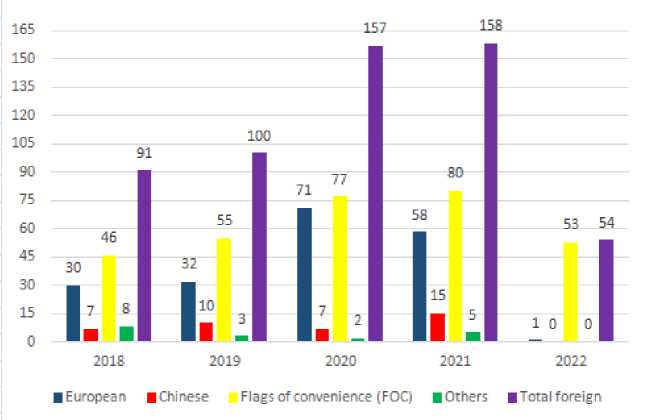
Fig.6. Foreign vessels on the NSR: permits issued by NSRA / Glavsevmorput 2018-2022 30 .
NSR inspection regime
Most of the Arctic states follow an inspection regime based upon documentation. For example, according to Russian national legislation, the mandate of the earlier NSR Administration, now - the Glavsemorput 31, is restricted to the scrutiny of documents. Decisions on whether to grant/restrict/revoke permission to enter the NSR do not mandate inspection of a vessel 32. Apart from the documentation submitted by the ship-owner, the NSR Administration is dependent upon port authorities and reports of violations to maritime administrations of flag states [16, Zagorski A., pp. 292-305]. Since 2016, the Federal Security Service of Russia (FSB) has been vested with investigating cases of violation of navigation rules within the area of the NSR 33. However, according to Russian researcher A. Todorov, the extent of the FSB’s mandate remains ambiguous, and this also pertains to the detention of non-compliant vessels in the NSR and other on-site enforcement activities [21, Todorov A., p. 326].
Discussion
The research indicates what lessons could be drawn by Arctic states from the experience of the last decade of heightened activity. The research highlights a weak mechanism for incident analysis and action taken; fledgling infrastructure and inadequate SAR assets. The Polar Code has been a significant step towards the safety of shipping in Polar waters, especially the Arctic. However, implementation depends upon the Arctic states, and there are deficiencies with the goal-based standards. The study indicates the need for greater cooperation between Arctic states and the possibility of greater control on the operation of vessels with flags of convenience (FOC).
Considering the above, we enunciate the main recommendations for the future development of Arctic shipping. Firstly, the Arctic Council needs to initiate a comprehensive updated shipping assessment. Secondly, the transport policies of both Arctic and non-Arctic states interested in navigating in these waters should include a policy to increase the safety of navigation in the Arctic, specifically by implementing a non-negotiable safety culture. Russia has to be the driver for such policies. The Russian government needs to contribute to ensuring safety to achieve the goal of safe Arctic shipping and of turning the NSR into an internationally competitive shipping transport corridor, even if this means sacrificing short-term and commercial interests, to pursue a policy of restricting the passage of ships under flags of convenience. Thirdly, Arctic governments could implement a policy on the basis of the British law on the dissemination of incident analysis affecting safety within a reasonable time-bound period. These need to be published and disseminated to the merchant shipping crew responsible for safe operation and the politicians and bureaucrats concerned with Arctic shipping policy. All governments could ensure that they have independent organisations certifying the Polar Code and carrying out incident analysis. Similarly, there could be an independent Agency for periodic (annual) certification of seafarers sailing, certified according to the Polar Code. Finally, the state transport policies of all Arctic states should include a policy of cooperation with other States of the Arctic Council to strengthen navigation support, communications and search and rescue (SAR) operations.
Conclusion
Independent regulatory bodies are necessary for all the Arctic states to ensure that the broad safety guidelines are adhered to. Follow-up analysis of incidents indicates a need for state transport policy to include safety aspects and reflect the requirements of an adequate oversight mechanism that takes into account safety culture and risk understanding. Arctic Council states could agree on banning ships with flags of convenience in Arctic waters, considering the incredibly fragile environment. Implementation of an Arctic specific PSC could enhance cooperation between Arctic states and ensure compliance by non-Arctic states interested in using Arctic waters. The Arctic shipping assessment needs to be made as a regular feature of the activities of the Arctic Council. There is also a need for analysis and follow-up action on shipping accidents in the Arctic to prevent future recurrence, for which Arctic governments may consider regulatory action. More significant cooperative efforts in all these areas, including search and rescue, could improve navigation safety and environmental protection.
Список литературы Maritime Shipping in the Arctic: Challenges and Opportunities to Improve Safety Must Be Reflected in the State’s Transport Policy
- Gorbunov A. A. Transportnaya politika gosudarstva: teoriya, istoriya, praktika [Transport Policy of the State: Theory, History, Practice]. Moscow, Prospekt Publ., 2020, 424 p. (In Russ.)
- Moe A. The Northern Sea Route: Smooth Sailing Ahead? Strategic Analysis, 2014, vol. 38, no. 6, pp. 784–802. DOI: 10.1080/09700161.2014.952940
- Humpert M. Briefing Note — Arctic Shipping: An Analysis of the 2013 Northern Sea Route Season. In: Arctic Yearbook 2014. Akureyri, Iceland, Northern Research Forum, 2014, 590 p.
- Marchenko N. Northern Sea Route: Modern State and Challenges. In: Proceedings of the ASME 33rd International Conference on Ocean, Offshore and Arctic Engineering (OMAE2014). San Francisco, 2014, pp. 1–10.
- Lasserre F., Alexeeva O. Analysis of Maritime Transit Trends in the Arctic Passages. In: International Law and Politics of the Arctic Ocean. Netherlands, Leiden, Brill Academic, 2015, pp. 180–192.
- Zhang Y., Meng Q., Zhang L. Is the Northern Sea Route Attractive to Shipping Companies? Some Insights from Recent Ship Traffic Data. Marine Policy, 2016, vol. 73, pp. 53–60. DOI: 10.1016/j.marpol.2016.07.030
- Gunnarsson B., Moe A. Ten Years of International Shipping on the Northern Sea Route: Trends and Challenges. Arctic Review on Law and Politics, 2021, no. 12, pp. 4–30. DOI: 10.23865/arctic.v12.2614
- Chircop A., Goerlandt F., Aporta C., Pelot R., eds. Governance of Arctic Shipping: Rethinking Risk, Human Impacts and Regulation. Switzerland, Springer Polar Sciences, 2020, 319 p.
- Lasserre F., Faury O., eds. Arctic Shipping: Climate Change, Commercial Traffic and Port Development. London, Routledge, 2021, 250 p. DOI: 10.4324/9781351037464
- Christodoulou A., Dimitrios D., Raneri P., Sheehan R. An Overview of the Legal Search and Rescue Framework and Related Infrastructure along the Arctic Northeast Passage. Marine Policy, 2022, vol. 138, pp. 1–9. DOI: 10.1016/j.marpol.2022.104985.
- Molenaar E.J. Port State Jurisdiction: Toward Comprehensive, Mandatory and Global Coverage. Ocean Development & International Law, 2007, vol. 38, iss. 1–2, pp. 225–257. DOI: 10.1080/00908320601071520
- Molenaar E.J. Options for Regional Regulation of Merchant Shipping outside IMO, with Particular Reference to the Arctic Region. Ocean Development & International Law, 2014, vol. 45, no. 3 , pp. 272–298. DOI: 10.1080/00908320.2014.929474
- Thorén A. Article 234 UNCLOS and the Polar Code — The Interaction Between Regulations on Different Levels in the Arctic Region: master thesis. University of Oslo, 2014, 71 p.
- Vylegzhanin A.N., Ivanov G.G., Dudikina I.P. Polyarnyy kodeks (otsenki i kommentarii v zarubezhnykh pravovykh istochnikakh) [The Polar Code (Comments in Foreign Legal Sources)]. Moskovskiy zhurnal mezhdunarodnogo prava [Moscow Journal of International Law], 2015, no. 4, pр. 43–60. DOI: 10.24833/0869-0049-2015-4-43-60
- Grant G.S. Implementation of the Polar Code. In: The Arctic in World Affairs: A North Pacific Dialogue on the Arctic in the Wider World. 2015 North Pacific Arctic Conference Proceedings. Korea Maritime Institute, Busan; Honolulu, East-West Center, 2015, pp. 190–205.
- Zagorski A. Implementation of the Polar Code. In: The Arctic in World Affairs: A North Pacific Dialogue on the Arctic in the Wider World. 2015 North Pacific Arctic Conference Proceedings. Korea Maritime Institute, Busan; Honolulu, East-West Center, 2015, pp. 292–305.
- Jensen Ø. The International Code for Ships Operating in Polar Waters: Finalization, Adoption and Law of the Sea Implications. Arctic Review on Law and Politics, 2016, no. 7 (1), pp. 60–82. DOI: 10.17585/arctic.v7.236
- Hindley R. The Role of the Polar Code in Arctic Maritime Governance. In: The Arctic in World Affairs: A North Pacific Dialogue on the Arctic in the Wider World. 2015 North Pacific Arctic Conference Proceedings. Korea Maritime Institute, Busan; Honolulu, East-West Center, 2019, pp. 182–192.
- Bai J., Wang C. Enhancing Port State Control in Polar Waters. Ocean Development & International Law, 2019, no. 50 (4), pp. 1–21. DOI: 10.1080/00908320.2019.1644776
- Todorov A.A. Sotrudnichestvo v oblasti portovogo kontrolya v Arktike kak instrument realizatsii Polyarnogo kodeksa [Arctic Port State Control as a Tool of Enforcement of the Polar Code]. Kontury global'nykh transformatsiy: politika, ekonomika, pravo [Outlines of Global Transformations: Politics, Economics, Law], 2019, no. 12 (5), pp. 160176. DOI: 10.23932/2542-0240-2019-12-5-160-176
- Todorov A. Coping with Deficiencies in the Polar Code: A Russian Perspective. The Polar Journal, 2020, vol. 10, iss. 2, pp. 322333. DOI: 10.1080/2154896X.2020.1799615.
- Todorov A. Russia’s Implementation of the Polar Code on the Northern Sea Route. The Polar Journal, 2021, vol. 11, iss. 1, pp. 30–42. DOI: 10.1080/2154896X.2021.1911044
- Engtrø E. A Discussion on the Implementation of the Polar Code and the STCW Convention’s Training Requirements for Ice Navigation in Polar Waters. Journal of Transportation Security, 2022, vol. 15 (1), pp. 41–67. DOI: 10.1007/s12198-021-00241-7
- Bhagwat J. The State Transport Policy for Development of the NSR in the USSR and the Russian Federation in the 20th Century. Arktika i Sever [Arctic and North], 2022, no. 47, pp. 76–99. DOI: 10.37482/issn2221-2698.2022.47.76
- Marchenko N., Andreassen N., Borch O.J., Kuznetsova S., Ingimundarson V., Jakobsen U. Arctic Shipping and Risks: Emergency Categories and Response Capacities. International Journal on Marine Navigation and Safety of Sea Transportation, 2018, no. 12 (1), pp. 107–114. DOI: 10.12716/1001.12.01.12
- Shaughnessy T., Tobin E. Flags of Inconvenience: Freedom and Insecurity on the High Seas. Journal of International Law & Policy, 20062007, vol. 5, pp. 1–31.

